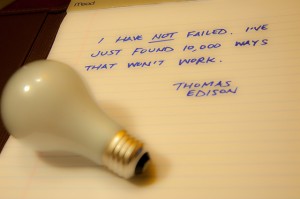 Last week I wrote an article entitled Think Like an Entrepreneur. It was a solid piece. The kind meant to encourage and inspire the creative, self-starter types to favor action over ideas. After all, we don’t praise the person who comes up with an idea and then does nothing. We applaud the person who executes; the person who goes first.
Last week I wrote an article entitled Think Like an Entrepreneur. It was a solid piece. The kind meant to encourage and inspire the creative, self-starter types to favor action over ideas. After all, we don’t praise the person who comes up with an idea and then does nothing. We applaud the person who executes; the person who goes first.
Of course, when you go first, you don’t actually know where you’re going; you have to figure it out along the way. Reid Hoffman, one of the founders of LinkedIn, says: Entrepreneurship is jumping off a cliff and assembling a plane on the way down. And, he’s right. It’s the process of going from chaos to concept before an abrupt and disastrous ending. It’s a process that’s difficult to understand and even more difficult to accept.
And, even if you’re able to grasp it and willing to go first, it doesn’t mean that you’ll be successful.
More often than not things don’t go according to plan, the project bombs and our projections are proven wrong. Then what? That’s exactly what one of the commenter’s on last week’s post wanted to know; what happens when you fail? What then, do you “keep on trucking?”
To which I would reply, yes! The only other options are quitting, not trying or living in fear. None of which are a viable option for any would be entrepreneur. A better approach would be to examine failure, understand what it is, why it happens and what to do about it.
Table of Contents
What Is Failure?
In an interview with the Harvard Business Review choreographer and creative Twyla Tharp shared her thoughts on failure. Tharp said, “all real change involves failure—but not in the sense that many people understand failure. If you do only what you know and do it very, very well, chances are that you won’t fail. You’ll just stagnate, and your work will get less and less interesting, and that’s failure by erosion. True failure is a mark of accomplishment in the sense that something new and different was tried.”
Tharp is telling us that we need to reframe how we think about failure. Too often we think of failure as the process of underachieving, where we come up short of our endgame. When this happens we define ourself or our business as a faillure. But, as Tharp points out, the true failure is the person who never starts or never tries by choosing to play it safe. What we should do is chastise the people standing on the sideline and praise the people who go first – even when they fail.
Doing nothing is a cop-out, failing is an accomplishment.
Why We Fail
Admittedly, reframing failure is only part of the process; we must also understand why we fail if we expect to learn from it.
Technically speaking there’s a number of reasons why new businesses fail. If there is no market for your product, or the market is too small, failure is in your future. And, just because there is a market for what you’re creating doesn’t mean anyone will buy it. If you enter the market at the wrong time or can’t convey your value proposition, you’re out of luck. Even if you convince some customers to buy something it doesn’t mean that they, or anyone else, will continue to do so. You must be able to articulate and execute a business model that acquires and then monetizes customers. And, the cost of acquiring a customer must be less than the lifetime value of said customer.
Right there we have five or six reasons how you can fail and we haven’t even touched on the problems related to capital, inventory, the management team/leadership, logistics, problems with the product and plain bad luck.
Like I said, you’re going to fail, just accept it. Instead of trying to avoid failure altogether, which ultimately equates to living in fear or never starting, think about how you will respond when you do fail.
Failing Better
No one sets out to fail, but that doesn’t mean you’ll be able to avoid it – especially if you’re going first. And, even if you’re willing to fail, it doesn’t mean it will sting any less. There will come a time where you find yourself lifeless on the floor, in the fetal position, crying – that happens. But, at some point you’ll have to get back in the game; which is why we need a plan for what to do when you do fail.
Plan to fail better. It’s what Richard Latman calls a good fail. In his book, The Good Fail, Latman explains that “A ‘good fail’ is a failure that has a learning value greater than the offset collateral damage,” he says. “These failures lead to new ideas about customers, innovations, and business plans.”
Failing better is about recognizing what we did well and what we did wrong. We must take a step back, analyze our actions and make changes accordingly. If we’re too committed to our process, our gut or our ego we’re bound to fail again.
And it’s failing again for the same reason that should terrify you. Failing is part of the process, not learning your lesson; that’s on you.
Have you ever tried something and failed? Did you quite or were you able to overcome it?

